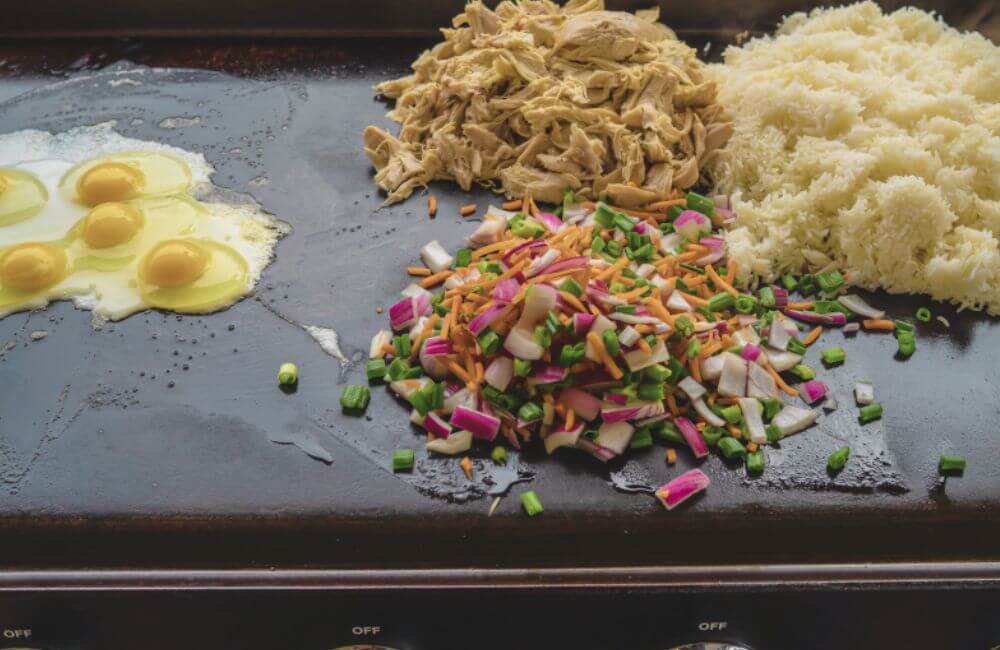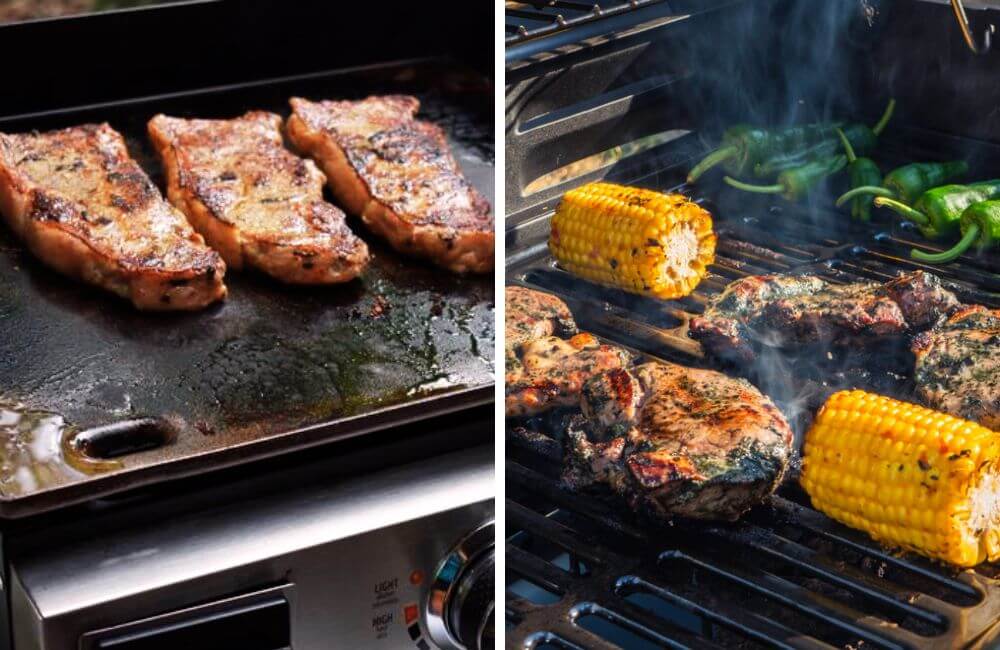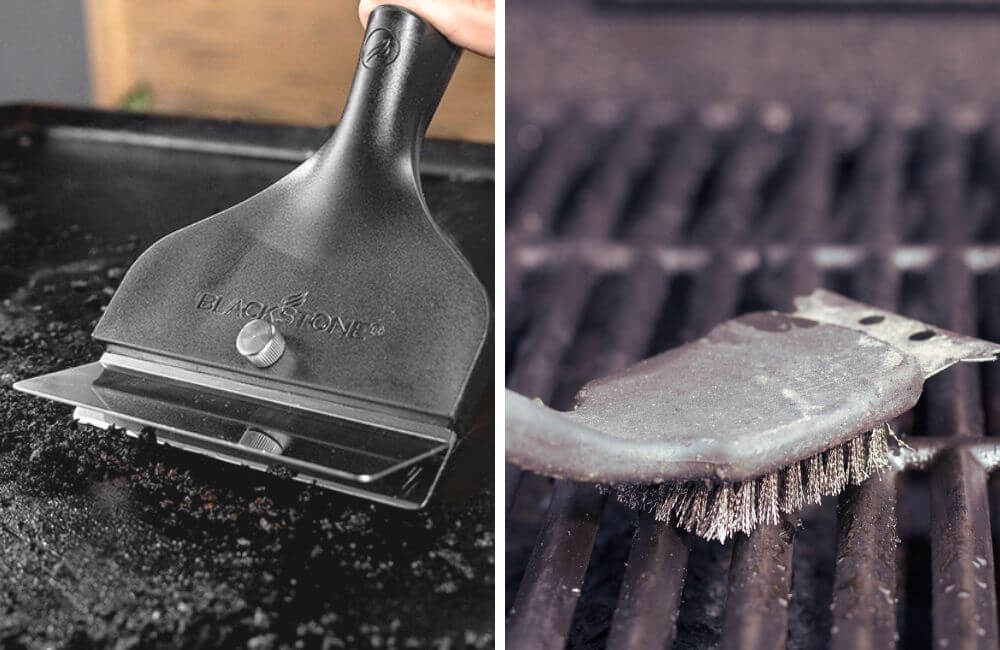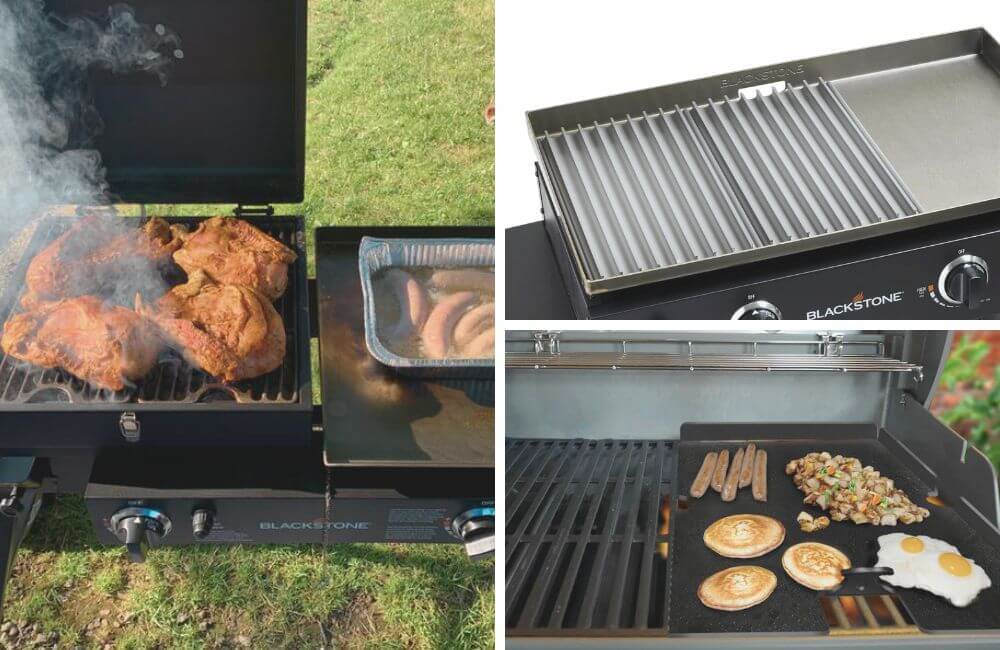As a BBQ newbie, you’re excited to fire up your first-ever backyard cookout. The anticipation is building, but there’s just one problem – should you go for a Blackstone griddle or a gas grill?
This culinary dilemma is all too familiar for anyone dipping their toes into the world of barbecues. Don’t worry; this article’s here to help!
It will explore the ins and outs of a Blackstone griddle and a gas grill, comparing everything from versatility to food quality, health aspects, maintenance, and durability.
So, stick around, and together, we’ll uncover the perfect cooking companion to make your BBQ dreams come true!
The Main Difference Between a Blackstone Griddle and a Gas Grill
Let’s kick off by discussing the key distinctions between Blackstone griddles and gas grills. At first glance, they might look like two sides of the same coin, but they’re actually quite different in terms of cooking methods and applications.
A Blackstone griddle features a large, flat cooking surface, perfect for evenly distributing heat across your delicious creations. This design allows you to cook a wide range of dishes, from pancakes and eggs to mouthwatering stir-fries, all with ease. The griddle’s smooth surface also ensures that food doesn’t stick, making for a hassle-free cooking experience.
On the flip side, a gas grill typically boasts an open grate design, allowing direct heat exposure from the flames below. This setup creates those much-loved grill marks on your food, giving your steaks and burgers that irresistible charred flavor. A gas grill is ideal for cooking larger cuts of meat, veggies, and even pizza if you’re feeling adventurous!
When it comes to versatility, both Blackstone griddles and gas grills have their unique strengths. Let’s dive into the cooking capabilities of each appliance and the types of foods you can prepare on them.

Which is More Versatile?
A Blackstone griddle is fantastic for cooking a wide variety of dishes, thanks to its large, flat surface. It’s perfect for whipping up breakfast favorites like pancakes, eggs, and bacon. You can also cook delectable stir-fries, sautéed veggies, and even delicate seafood like shrimp or fish. The griddle is also great for toasting buns or making quesadillas and grilled cheese sandwiches.
On the other hand, a gas grill shines when cooking larger cuts of meat, such as steaks, burgers, and ribs. It’s also fantastic for grilling veggies and fruits; with the right accessories, you can even cook pizza! The open grate design allows for that smoky, charred flavor we all know and love.
Here’s a table showcasing some dishes that can be cooked or not cooked on a flat-top grill vs a gas grill. The “Y” indicates that the appliance can cook the dish, while “N” indicates it cannot.
| Dish | Blackstone Griddle | Gas Grill |
|---|---|---|
| Pancakes | Y | N |
| Eggs | Y | N |
| Bacon | Y | N |
| Stir-fry | Y | N |
| Quesadilla | Y | N |
| Steak | Y | Y |
| Burgers | Y | Y |
| Ribs | Y | Y |
| Grilled vegetables | Y | Y |
| Grilled fruit | N | Y |
| Pizza | Y (thin) | N |
| Sautéed vegetables | Y | N |
| Delicate seafood | Y | Y |
| Veggie skewers | Y | Y |
| Grilled sandwich | Y | Y |
| Roasted whole chicken | N | Y (with indirect heat) |
Now, let’s compare the cooking times for some dishes that can be prepared on both appliances. Remember that these times may vary depending on the specific model, heat settings, and other factors.
| Cookable Dish | Blackstone Griddle | Gas Grill |
|---|---|---|
| Steak | 8-12 minutes | 10-14 minutes |
| Burgers | 8-10 minutes | 10-12 minutes |
| Chicken breasts | 12-15 minutes | 12-18 minutes |
| Chicken wings | 12-18 minutes | 15-20 minutes |
| Shrimp | 4-6 minutes | 4-6 minutes |
| Veggie skewers | 10-15 minutes | 12-15 minutes |
| Grilled sandwich | 4-6 minutes | 4-6 minutes |
As you can see, both the griddle and gas grill offer unique cooking capabilities. The choice between the two ultimately depends on your cooking preferences, skills, and the types of dishes you want to create in your outdoor kitchen.
Which is Better for Food?
Choosing between a gas grill and a griddle can be a challenge when deciding which is better for food. Both cooking methods offer unique taste and texture advantages, and the preference often boils down to individual tastes. Let’s explore some examples to understand the differences.
Steak on Blackstone Vs Grill
Regarding cooking steaks, a gas grill provides attractive grill marks and a slightly better texture, thanks to the direct fire. The grate also allows some salt to fall through, resulting in a less salty taste.
However, a steak cooked on a Blackstone griddle retains more juice and is generally softer, making it a popular choice for those who prefer a more tender bite.
Burger on Grill Vs Blackstone
Now, let’s talk burgers. A burger cooked on griddle benefits from more surface contact, leading to increased caramelization and flavor. The griddle also helps retain fat and moisture, producing a juicier and more tender burger. However, this cooking method lacks the distinct char marks and smoky taste many burger aficionados crave.
On the other hand, a burger cooked on a gas grill offers those desirable char marks and smoky flavors but may have less caramelization and tend to be drier due to the loss of fat and moisture.
Ultimately, the choice between these grill types depends on the specific tastes and textures you enjoy in your food.
- The griddle might be your best bet if you prefer a juicier, more caramelized result.
- Conversely, if you love those char marks and the smoky flavor of direct flame exposure, a gas grill could be the better option.

Is Blackstone Griddle Healthier Than Gas Grill?
When considering the health implications of cooking on Blackstone griddles compared to gas grills, it’s essential to understand the cancer-causing substances that can be produced during the grilling process.
While both appliances can produce heterocyclic amines (HCAs), gas grills additionally produce polycyclic aromatic hydrocarbons (PAHs), which form when meat juices drip onto the heat source and flare up. This means that, from a health perspective, griddles may have a slight advantage over gas grills.
Despite this difference, it’s important to take precautions when cooking on either appliance to minimize exposure to these harmful substances. Here are some tips to help ensure healthier cooking on both griddles and gas grills:
Trim visible fat and choose lean cuts: Reducing the amount of fat and oil that reacts with high heat can help minimize the formation of HCAs. Opt for lean cuts of meat and trim off any visible fat before cooking.
Marinate the meat: Marinating meat before cooking can reduce the formation of HCAs by up to 90 percent. This not only enhances the flavor but also promotes a healthier meal.
Cook at lower temperatures: Avoid overcooking or charring your meat, as this can increase HCAs. Cooking at a lower temperature helps prevent this while still delivering a delicious, juicy result.
Flip meat frequently: Turning your meat more often and using a meat thermometer to ensure it reaches a safe internal temperature can reduce cooking time and the formation of HCAs.
Maintain a balanced diet: Including plenty of fruits and vegetables in your meals can provide antioxidants and phytochemicals that counteract the effects of HCAs. This promotes a well-rounded, healthy diet that complements your grilling endeavors.

Which is More Maintenance and Durable?
When comparing the maintenance and durability of the two, it’s important to consider the specific needs and care required for each appliance.
Blackstone griddles have a relatively low maintenance profile. Cleaning the cooking surface after each use is essential to keep the griddle in top shape. Scraping off food residue with a grill brush or scraper is usually sufficient, followed by a quick wipe with a damp cloth.
It’s also important to season the griddle surface regularly to maintain a non-stick coating and prevent rusting. This process involves applying a thin layer of oil to the surface and heating it until it reaches the smoke point. Over time, the griddle will develop a dark, non-stick patina that enhances its performance and longevity.
On the other hand, gas grills require more maintenance due to their complex components. Regular cleaning of the grates, burners, and drip trays is necessary to prevent grease buildup, flare-ups, and uneven heat distribution. While gas grills tend to have a higher maintenance demand, they can be just as durable as a Blackstone griddle with proper care.
Because both use propane tanks, checking the propane connections and hoses periodically for any signs of wear or leaks is also crucial.
In terms of durability, both appliances can last for many years when cared for properly. High-quality materials and construction play a crucial role in the longevity of these outdoor cooking devices. For example, stainless steel or cast iron components offer excellent durability and rust resistance.
Ultimately, the choice in terms of maintenance and durability will depend on your personal preferences and how much time and effort you’re willing to invest in the upkeep. While griddles may require less maintenance, both appliances can provide long-lasting, enjoyable outdoor cooking experiences when properly maintained.
Pros and Cons of Griddle Vs. Gas Grill
Here’s a comparison table to help you better understand the pros and cons of each appliance.
| Griddle | Gas Grill | |
|---|---|---|
| Pros | Even heat distribution Great for searing Low-maintenance No flare-ups Versatile cooking options |
Authentic grill flavor Beautiful grill marks Wide temperature range Direct and indirect cooking methods Can be used as a griddle with accessories |
| Cons | Limited grill marks No smoky flavor Limited to flat surface Less outdoor ambiance |
More maintenance required Flare-ups can occur Less even heat distribution Higher risk of producing PAHs |
Do You Want a Griddle or a Gas Grill?
After exploring the realm of outdoor cooking and comparing the Blackstone griddle with the gas grill, it’s evident that each appliance has unique advantages and disadvantages.
So, which appliance should you choose? It ultimately depends on your personal preferences and cooking needs.

While the Blackstone griddle offers even heat distribution, excellent searing capabilities, and low maintenance, it lacks the smoky flavor and grill marks many BBQ enthusiasts crave. Therefore, a griddle cannot replace a gas grill if you’re after that smoky flavor, especially when adding wood chips. You can only achieve grill marks on the griddle using a grill grate like the Sear’NSizzle Grate.
On the other hand, the gas grill provides authentic flavor, beautiful grill marks, and a wider temperature range but demands more maintenance and has a higher risk of flare-ups. Despite this, you can easily convert a gas grill into a griddle using a grill pan or a griddle grate. Doing so will obtain the smoky flavor and retain the meat’s juiciness, much like cooking on a griddle. However, it won’t be as efficient as a dedicated griddle.
If you’re still having trouble deciding, consider investing in a gas grill and griddle combo, such as the Blackstone Tailgater, which offers the best of both worlds. This versatile option allows you to enjoy various dishes and cooking styles without sacrificing the benefits of either appliance.
Conclusion
Whether you opt for a gas grill or a Blackstone griddle, it’s crucial to weigh the pros and cons and consider your unique outdoor cooking needs. Don’t hesitate to experiment and find the perfect setup for your backyard BBQ adventures.
Remember, the most enjoyable outdoor cooking experiences often come from sharing your culinary creations with friends and family. So, share your thoughts, experiences, and recommendations with fellow outdoor cooking enthusiasts. Happy grilling!

I’m Jackson. I’ve been experimenting with different recipes and techniques to make the perfect plate of smoked or grilled meat for many years. I started this blog to share my experience with others who love grilling and smoking just as much as I do. Here you’ll find recipes, tips, tricks, and everything you need to know about making mouth-watering grilled or smoked dishes.

